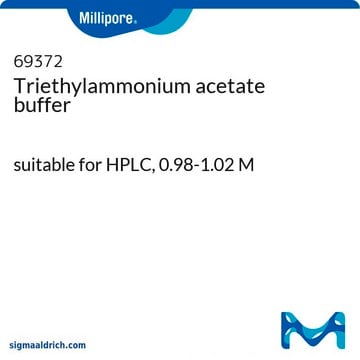90358
Triethylammonium acetate buffer
volatile buffer, ~1.0 M in H2O
Synonym(s):
Triethylammonium acetate buffer, Buffer solution 1 M pH 7.0 (volatile)
About This Item
Recommended Products
Quality Level
Assay
0.95—1.05 mol
form
liquid
shelf life
limited shelf life, expiry date on the label
storage condition
dry at room temperature
concentration
1 M
~1.0 M in H2O
technique(s)
electrophoresis: suitable
color
colorless
refractive index
n20/D 1.357
pH
7.0
6.1
density
1.002 g/mL at 20 °C
suitability
suitable for chromatography
suitable for protein modification
suitable for separation of small nucleic acid fragments
application(s)
detection
diagnostic assay manufacturing
life science and biopharma
sample preparation
storage temp.
2-8°C
InChI
1S/C6H15N.C2H4O2/c1-4-7(5-2)6-3;1-2(3)4/h4-6H2,1-3H3;1H3,(H,3,4)
InChI key
AVBGNFCMKJOFIN-UHFFFAOYSA-N
Related Categories
General description
Application
- as a buffer in proteomics studies
- as a component of the mobile phase to separate nucleotide sugars
- as a buffer for the separation of glycopeptides in proteomics research
Features and Benefits
- Suitable for Biological and Biochemical Research
- Ready available solution reduce the need for preparation time
Other Notes
Storage Class Code
12 - Non Combustible Liquids
WGK
WGK 3
Flash Point(F)
Not applicable
Flash Point(C)
Not applicable
Personal Protective Equipment
Certificates of Analysis (COA)
Search for Certificates of Analysis (COA) by entering the products Lot/Batch Number. Lot and Batch Numbers can be found on a product’s label following the words ‘Lot’ or ‘Batch’.
Already Own This Product?
Find documentation for the products that you have recently purchased in the Document Library.
Customers Also Viewed
Articles
Optimized separation of Oligo Standard 6, an internally created HPLC-UV system suitability mix, on Chromolith® RP-18e columns with an evaluation of the effect of flow rates up to 3 mL/min and ion-pairing reagent, TEAA, on the separation.
Our team of scientists has experience in all areas of research including Life Science, Material Science, Chemical Synthesis, Chromatography, Analytical and many others.
Contact Technical Service











